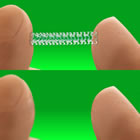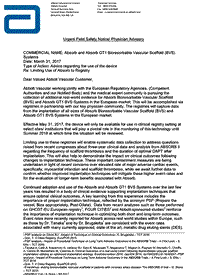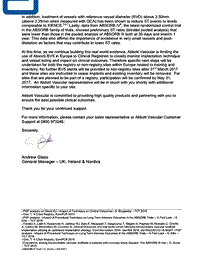 Last night news began circulating on Twitter that Abbott’s Absorb BVS (Bioresorbable Vascular Scaffold) was being withdrawn from the European market. This information was prompted by several physicians posting on Twitter a March 31 “Urgent Field Safety Notice/Physician Advisory” letter from Abbott addressed to “Valued Abbott Vascular Customer.”
Last night news began circulating on Twitter that Abbott’s Absorb BVS (Bioresorbable Vascular Scaffold) was being withdrawn from the European market. This information was prompted by several physicians posting on Twitter a March 31 “Urgent Field Safety Notice/Physician Advisory” letter from Abbott addressed to “Valued Abbott Vascular Customer.”
A number of news sources, including this one, posted articles and tweets to the effect that the Absorb was being taken off the commercial markets and, as the letter stated, “Effective May 31, 2017, the device will only be available in clinical register setting at select sites/institutions that will play a pivotal role in the monitoring of this technology until Summer 2018 at which time the situation will be reviewed.”
This morning Abbott reacted to this initial flurry of reports that they had “pulled the Absorb” with some clarification: specifically that the Absorb is NOT being pulled from the market and still retains the CE Mark. An Abbott spokesperson told Angioplasty.Org, “Absorb will continue to be commercially available in Europe through the registries.”
But the relationship, as they say on Facebook, is complicated.
First, here’s the letter (click each page for enlargement).
The letter states that, as of March 31, Abbott will no longer be supplying the BVS to non-registry sites in Europe, that those sites should cease implantation, and that remaining BVS product will be removed by the company. By the end of May, registry sites will have been confirmed and that only those sites will be able to use the Absorb BVS. By the Summer of 2018, the results from these registry sites will be examined and the situation reviewed. (A registry site is one in which the operators have been trained in proper implantation technique and patient selection, and also required to report details of all procedures performed with the Absorb.)
So, yes: it’s complicated. The device is not being withdrawn. Rather what Abbott is doing, in effect, is to rein in the use of Absorb in Europe to conform more closely to the conditions of the more recent approvals in the U.S. and Japan, these conditions having been formulated from clinical data presented since the CE Mark was given. Abbott quickly sent out clarifications to members of the medical press, but just a note here to Abbott: when people in the press see a document titled, “Urgent Field Safety Notice/Physician Advisory” letter, they tend to start writing. Quickly.
Approvals With and Without Conditions
The Absorb BVS was given the CE Mark, allowing sale in Europe, way back in 2011. Abbott didn’t begin distributing the device until later in 2012. Then, four years later – just last July – the FDA approved the Absorb for use in the United States. In November, Absorb was approved in Japan.
At the time of the FDA approval, clinical studies showed that the BVS was non-inferior to the workhorse Xience DES, also manufactured by Abbott. There was data, however, pointing to increased adverse event rates, especially stent thrombosis. An analysis of the clinical studies broke out those cases according to vessel diameter and the results revealed that the events rates were considerably higher in arteries narrower than 2.5mm. Therefore, the FDA approval, and package labeling, indicated the device was approved for use only in vessels 2.5mm to 3.75mm. Additionally, because it was also noted that careful implantation technique was critical, the FDA approval letter stated, “…the labeling must specify the specific training or experience practitioners need in order to use the device.” Similar conditions were placed on the Absorb BVS in Japan, as reported by our Japanese partner, TCROSS NEWS.
The earlier European CE Mark approval had no such conditions or restrictions, since it had come well before the safety signals seen in narrower arteries and understanding of the importance of proper implantation technique.
Latest Findings Confirm Safety Issues
At the latest American College of Cardiology meeting in March, just an hour before the two year results from the latest ABSORB III trial were to be presented, the FDA in effect broke the embargo and published a “Letter to Healthcare Providers,” discussing these increased events seen with the Absorb BVS. Then just last week, the Amsterdam Investigator-Initiated Absorb Strategy All-Comers Trial (AIDA) study was published in the New England Journal of Medicine, showing a four-fold increase in stent thrombosis rates at two-years. Again, all these issues of increased stent thrombosis et al had already been discussed. But there’s no doubt that these ongoing reports prompted Abbott to take the action it has.
It’s a correct decision for patient safety, to be sure. But it’s also important to the future of the Absorb platform: to determine if the long term results are comparable or superior to current DES when the proper PSP technique is utilized: lesion Preparation, correct Sizing, and Post-dilatation. Blinded results from the current study, ABSORB IV, indicate that the adverse event rate when proper technique is followed is significantly reduced and is comparable to the best-in-class DES.
Will the Bioresorbable Vascular Scaffold Improve the Treatment of CAD?
The Absorb originally was touted as a revolution in the treatment of coronary artery disease. The BVS could be placed like a standard drug-eluting metal stent, but would disappear over three years, leaving the native artery open and normal, unencumbered by a metal sleeve, able to flex, expand, and contract. Additionally, should the patient’s disease progress and bypass graft surgery be needed in the future, there would be no stent compromising where in the artery the bypass could be placed. When the FDA approval came, there were immediately scores of articles touting the “revolution” in local newspapers, mostly those that covered the geographic areas around hospitals offering this device. If you just read the popular press, you’d believe that a major advance had indeed been made. However, if you had attended any of the major cardiology meetings during the past year, you’d have heard a somewhat different story, as indicated above.
When the Absorb was first approved, Angioplasty.Org spoke with three influential interventional cardiologists about the device: Drs. Ajay Kirtane, Daniel Simon, and James Blankenship. Our article, “Will Abbott’s Absorb Bioresorbable Vascular Scaffold Revolutionize Treatment of Coronary Artery Disease?” contained a number of concerns and critiques of the Absorb, that it was more expensive, more time-consuming to implant, more difficult to implant, required additional intravascular imaging, additional balloons, and had not shown any advantage over the standard current generation of drug-eluting stents. In fact, some of the data from the clinical trials showed some warning signals of increased stent thrombosis rates. Read their comments.
Of course, as Dr. Blankenship pointed out, the current Absorb is a first generation device. Abbott and other companies are testing improved versions with stronger, thinner struts. The big question is whether the bioresorbable “brand” will be able to overcome the negative results so far in the eyes of the interventional community.
(Note: this article has been significantly revised since its initial posting at 00:14 April 6, 2017, including the headline.)






Very nicely written, giving an understanding of the whole process – and showing some lack of awareness on their part of how the modern world shares information.
Thanks for al the details.
Just out of curiosity, if these things disappear in three years, how long is dual anti-platelet therapy required/recommended for them?
And can they go in, remove the DES you have, and replace them with the absorbable ones?
There really was no ‘informed consent’ going on when the stents I have were implanted in February.
Very good info about stents in Europe.
Thanks for the article.